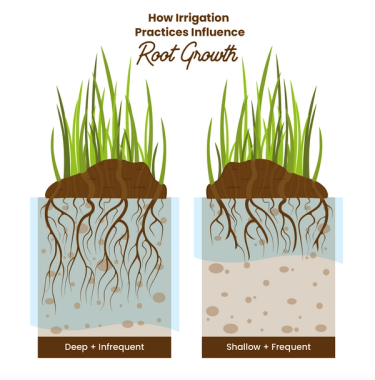What do roots do for lawns and grass?
Roots control the uptake of nutrients and water to the grass and store the carbohydrates grass uses for energy. They also alert the grass to stressful conditions, like poor soil conditions, and send signals to the grass shoots to increase resiliency when necessary.
What are the benefits of deep roots?
The longer the roots, the better, as there are many benefits of deeper roots, including:
- access to more reservoirs for water and nutrients
- access to more organic matter
- increased microbial life, meaning increased aeration or oxygen for your grass

Sunday Tip:
Grass roots can grow to be anywhere between 6 inches and a foot long. Before grass shoots emerge above ground, some roots have likely already grown 2–3 inches into the soil. This is why daily watering your seed after planting is so critical to your lawn’s success!
Why do some roots not grow deep enough, or at all?
Without proper care at the early stages of planting, grass roots won’t be able to grow to their fullest potential. Some reasons why your roots may be shallow, or not growing at all, include:
- watering incorrectly, or poor drainage
- poor-quality soil (urban soils, compacted or clay soils, low organic matter, poor layering of soil, poor pH)
- high traffic
- poor temperatures or extreme weather conflicts
How to fix shallow grass roots or grow deeper grass roots
If your grass is looking unhealthy, or is otherwise showing signs of shallow roots, know that your lawn isn’t a lost cause. There are, in fact, many ways to help fix shallow grass roots!
- First, fix your current watering practices. Chances are if you have shallow grass roots, you’re likely not watering correctly. To encourage deep root development, practice deep and infrequent irrigation. How to do this: Limit watering to 2–3 times per week, opt for uniform coverage as much as possible, and try to water about 0.5 inches per watering session (~30 minutes).
- Hand-pull and spot-treat weeds. Removing weeds from the lawn will provide more space for grass roots to grow, and create less competition from weeds—and their roots.
- Apply Sunday nutrients. Frequent and low-nitrogen application of nutrients (like Sunday’s Smart Lawn Plan!) will help maintain a healthy rootzone and promote deep root growth.
- Overseed the entire lawn and patch bare areas. Introducing more resilient, regionally adapted, and diverse blends of grass seed will enocurage deeper-rooting grass that’s also able to outcompete weeds the following year.
- Water in seeds correctly. Water daily to keep the seeds in the soil moist, but then switch to watering deeply and infrequently once the seeds germinate. When you water deeply and infrequently, you’re training the grass roots to grow deeper.
- Mow your lawn at the proper height. Once your healthy grass is ready, mow high, follow the ⅓ inch rule, and cut grass according to the proper height for grass type.
Cited sources
Hormones from roots as signals for the shoots of stressed plants. Trends in Plant Science.
Roots | Forage Information System. Oregon State University Extension.
The Cool-Season Turfgrasses: Basic Structures, Growth and Development. Penn State Extension.
Turfgrass Root Basics. Beard, 2001.



















